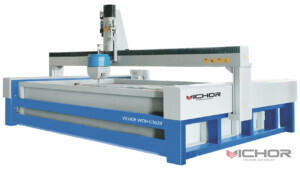
7 Insider Secrets to Mastering Water Jet Cutter Speed for Precision Results
When it comes to industrial cutting, water jet cutter speed isn’t just a technical detail—it’s the heartbeat of efficiency and precision. Imagine a tool that slices through metal, stone, or composites with the force of a hyper-pressurized stream, all while maintaining razor-sharp accuracy. But how fast can it really go? And what happens when the speed is too high or too low? In this article, we’ll unravel the mysteries behind water jet cutter speed, diving into the factors that influence it, how it impacts your projects, and practical tips to harness its full potential. Whether you’re a seasoned engineer or a curious newcomer, understanding water jet cutter speed can transform your workflow, saving time and reducing waste. Let’s explore why this variable is a game-changer in modern manufacturing.
What Exactly Is Water Jet Cutter Speed?
Water jet cutter speed refers to the rate at which the cutting head moves across a material during the ablation process. Measured in units like inches per minute (IPM) or millimeters per second, this parameter dictates how quickly a water jet system can complete a cut. Unlike traditional tools, water jets use a high-velocity stream—often mixed with abrasives—to erode materials, and the speed must be calibrated to balance efficiency with quality. For instance, cutting through soft materials like foam might allow for higher water jet cutter speeds, while hard metals require slower, more controlled rates. This foundational aspect affects everything from production timelines to operational costs, making it a central focus in optimizing water jet systems. By grasping the basics, you can start to see why tweaking water jet cutter speed is akin to fine-tuning a high-performance engine.
Key Factors That Influence Water Jet Cutter Speed
Several elements interact to determine the optimal water jet cutter speed, and ignoring any one of them can lead to subpar results. First, material hardness plays a pivotal role—softer substances like rubber or aluminum permit faster cutting, whereas hardened steel or ceramics demand reduced speeds to avoid imperfections. Second, the thickness of the material is critical; thicker sections require slower water jet cutter speeds to ensure the stream penetrates fully without leaving uncut areas. Third, the type of abrasive used, such as garnet or aluminum oxide, affects the erosion rate, with finer abrasives often enabling smoother cuts at moderate speeds. Fourth, water pressure, typically ranging from 50,000 to 90,000 PSI, directly impacts speed—higher pressure can increase the water jet cutter speed but may escalate wear and tear. Lastly, nozzle condition and orifice size influence the stream’s focus; a worn nozzle can scatter the jet, forcing slower speeds to maintain accuracy. By addressing these factors holistically, operators can achieve a harmonious balance that maximizes throughput without sacrificing precision.
How Water Jet Cutter Speed Affects Cut Quality and Accuracy
The relationship between water jet cutter speed and cut quality is a delicate dance—too fast, and you risk rough edges or taper; too slow, and you might incur excessive material removal or heat buildup. At optimal water jet cutter speeds, the cut edges remain smooth and precise, with minimal kerf width (the gap created by the cut). For example, in applications like aerospace component manufacturing, even minor deviations in speed can lead to part rejection due to dimensional inaccuracies. Additionally, slower water jet cutter speeds often produce straighter cuts in thick materials, as the stream has more time to abrade evenly. Conversely, high speeds might cause “lag” or curvature in the cut path, especially in dense metals. This interplay underscores why monitoring water jet cutter speed in real-time, using advanced CNC controls, is essential for maintaining consistency across batches. Ultimately, mastering this aspect ensures that your projects meet stringent quality standards while minimizing post-processing efforts.
Optimizing Water Jet Cutter Speed for Different Materials
Tailoring water jet cutter speed to specific materials is where science meets artistry. For non-metallic materials like wood or plastics, speeds can reach up to 100 IPM or more, thanks to their lower density and abrasion resistance. In contrast, metals such as titanium or stainless steel might require speeds as low as 5–20 IPM to avoid micro-fractures or edge hardening. Composite materials, common in automotive industries, need moderate water jet cutter speeds—around 10–40 IPM—to prevent delamination. A practical approach involves conducting test cuts at varying speeds and inspecting the results under magnification. For instance, increasing the water jet cutter speed incrementally while assessing edge smoothness can help identify the sweet spot. Moreover, environmental factors like water purity and ambient temperature can subtly influence performance, so documenting these variables in a speed chart for common materials can serve as a handy reference. By customizing water jet cutter speed based on material properties, you enhance both efficiency and product longevity.
The Role of Abrasives in Enhancing Water Jet Cutter Speed
Abrasives are the unsung heroes that amplify water jet cutter speed, transforming a plain water stream into a powerful cutting tool. Typically, garnet is the go-to abrasive due to its hardness and cost-effectiveness, allowing for faster cuts in metals and ceramics. The grain size and flow rate of the abrasive directly correlate with water jet cutter speed—finer grains enable quicker material removal in thin sheets, while coarser grains handle thick slabs at slower paces. For example, a higher abrasive flow rate can boost water jet cutter speed by intensifying the erosion process, but it also increases consumption costs. Innovations in abrasive recycling systems are now helping to mitigate this, enabling sustainable speed optimization. It’s worth noting that pure water jets (without abrasives) are limited to softer materials and generally operate at higher speeds, but they lack the versatility of abrasive-assisted systems. Thus, selecting the right abrasive type and dosage is crucial for pushing the boundaries of water jet cutter speed without compromising economics.

Measuring and Monitoring Water Jet Cutter Speed in Real-Time
In today’s automated workshops, real-time monitoring of water jet cutter speed is non-negotiable for precision. Advanced CNC systems integrate sensors and software that track the cutting head’s velocity, adjusting it dynamically based on material feedback. For instance, if a sensor detects an inconsistency in material density, the system can automatically reduce the water jet cutter speed to prevent errors. Tools like laser calibration and high-speed cameras provide visual data on stream behavior, helping operators fine-tune speeds for complex geometries. Additionally, data logging allows for historical analysis, identifying trends that could predict maintenance needs—like nozzle wear—that might slow down optimal water jet cutter speed. By embracing these technologies, businesses can achieve a proactive approach, reducing downtime and ensuring that every cut meets design specifications. This continuous loop of measurement and adjustment is what sets top-tier operations apart, turning water jet cutter speed from a static setting into a dynamic asset.
Future Trends in Water Jet Cutter Speed Technology
The evolution of water jet cutter speed is poised to accelerate with emerging technologies. Artificial intelligence and machine learning are being integrated to predict optimal speeds based on material databases, reducing trial-and-error time. For example, AI algorithms could analyze a material’s composition and recommend a water jet cutter speed that maximizes throughput while minimizing abrasive use. Another trend is the development of hybrid systems that combine water jets with lasers or plasma, allowing variable speed adjustments for multi-material projects. Moreover, advancements in pump technology aim to deliver higher pressures more efficiently, potentially doubling current water jet cutter speeds without increasing energy consumption. Sustainability is also a driver, with research focused on water recycling and eco-friendly abrasives that maintain high speeds. As these innovations unfold, the industry will see water jet cutter speed becoming more adaptive, intelligent, and integral to smart manufacturing ecosystems.
Water jet cutter speed is far more than a number on a control panel—it’s a multifaceted variable that influences productivity, quality, and cost-effectiveness. From material compatibility and abrasive selection to real-time monitoring and future tech, every aspect interconnects to define the success of your cutting operations. By deepening your understanding of water jet cutter speed, you can unlock new levels of precision and efficiency, whether you’re crafting intricate designs or handling heavy-duty industrial tasks. As technology advances, staying informed about these developments will ensure you remain at the forefront of the field. So, the next time you hear the hum of a water jet, remember that its speed holds the key to unparalleled performance.
Frequently Asked Questions About Water Jet Cutter Speed
Q1: What is the average water jet cutter speed for cutting stainless steel?
A1: The average water jet cutter speed for stainless steel typically ranges from 5 to 20 inches per minute (IPM), depending on thickness. For example, a 1-inch thick plate might require speeds around 5–10 IPM to ensure a clean, taper-free cut, while thinner sheets can be cut faster.
Q2: How does water jet cutter speed impact operating costs?
A2: Water jet cutter speed directly affects operating costs by influencing abrasive consumption, energy use, and labor time. Higher speeds can reduce cycle times and labor costs but may increase abrasive wear and require more frequent nozzle replacements, so balancing speed with resource efficiency is crucial.
Q3: Can water jet cutter speed be adjusted during a cutting job?
A3: Yes, modern CNC-controlled water jet systems allow real-time adjustments to water jet cutter speed. Operators can program speed variations for different sections of a cut, such as slowing down for intricate curves or accelerating on straight paths, to optimize quality and efficiency.
Q4: What are the signs that my water jet cutter speed is too high?
A4: Signs of excessive water jet cutter speed include rough or tapered edges, incomplete cuts, increased abrasive usage, and noticeable lag in the stream path. If you observe these issues, reducing the speed and conducting test cuts can help restore cut quality.
Q5: How do I determine the ideal water jet cutter speed for a new material?
A5: To find the ideal water jet cutter speed for a new material, start with manufacturer recommendations or industry databases, then perform test cuts at incremental speeds. Inspect the edges for smoothness and accuracy, and use software simulations if available to model performance before full-scale production.
This article provides a comprehensive overview of water jet cutter speed, covering its fundamentals, influencing factors, and practical applications. By focusing on these aspects, you can make informed decisions to enhance your cutting processes. If you have more questions, consult with industry experts or refer to technical guidelines for tailored advice.
continue reading
Related Posts
- 2056 words10.3 min read
- 1968 words9.9 min read


